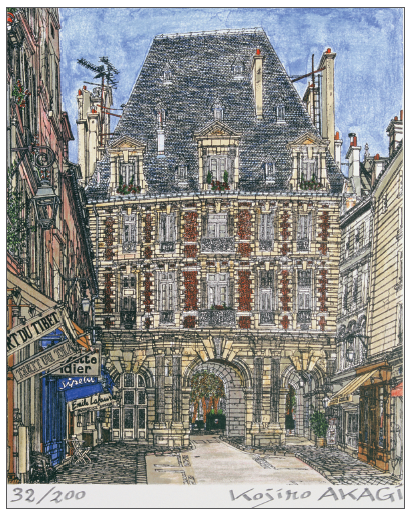Rue de Birague / Rue de Birague / ビラーグ通り
Dublin Core
Title
Rue de Birague / Rue de Birague / ビラーグ通り
Subject
Rue, Lithographie
Description
Cette rue a été ouverte en 1605. A son extrémité se trouve la résidence d’Henri IV, appelée Pavillon du Roi. Un peu plus loin, en franchissant le porche, on débouche sur la fameuse place des Vosges. Elle est construite au début du 17e siècle sous l’ordre du roi et les aristocrates s’installent dans les bâtiments qui l’entourent. L’aspect harmonieux et uniforme des façades est resté le même qu’à l’époque de leur construction. C’est une place splendide, un lieu incontournable pour les touristes de passage. A proximité de la Seine, des terrains marécageux ont été défrichés pour la construction d’un monastère, puis le roi, trop à l’étroit dans Paris, s’installa ici afin de profiter de plus d’espace et d’améliorer son confort. A l’origine, ce quartier était constitué de marais et c’est pourquoi il a conservé cette appellation jusqu’à aujourd’hui. Avec le temps, les bâtiments ont vieilli ; pour en construire de nouveaux, il a fallu aller plus à l’Ouest. La topographie de Paris est telle que, à l’Ouest, les vents venant de l’océan atlantique balayent fumées et poussières. L’Est reste, lui, submergé d’un flot de poussières. De plus, côté ouest, on profite davantage du coucher du soleil. Le soleil et le vent sont donc deux éléments qui ont permis à Paris de se développer à l’Ouest.
This street opened in 1605. At its end is Henri IV’s residence called “Pavillon du Roi” and the furthest part after passing through the arcade is the famous Place des Vosges. In the beginning of the 17th century, the Place was made at the king’s command and all the nobles at that time lived surrounding the Place. Still now, the building remains as it was, so it is a beautiful square with an integrated style which tourists never fail to visit.The area around here used to be the marshes of the Seine but monasteries reclaimed them and kings left the heavily populated districts in Paris to build residences in spacious land and live comfortably. Because the land used to be marshland it is called Le Marais and many noblemen’s residences were also built around here. They gradually became older and older and, when they build new ones, they move to the west side. One geographical feature of Paris is that wind blows from the Atlantic Ocean and therefore makes it comfortable to be on the windward side because there is little smoke, the east side tending to be dust dump. In addition, the setting sun penetrates rooms deeply for a long time to make it light until late so it was an element to make the city grow predominantly towards the west.
一六〇五年に開かれた通り。突き当たりが「王様の館」と呼ばれるアンリ四世の住まいで、アーケードを抜けたこの奥が有名なボージュ広場となる。十七世紀の始めに、王様の命令でこの広場を作り、当時の貴族がみんな、広場を囲んで住んだのだった。いまでも建物はそのまま残っているので、様式の統一された、観光客の必ず訪れる美しい広場である。 この辺り一帯、セーヌ河の沼地だったが、僧院が開墾し、王様が人家の密集するパリを出て、広々とした土地に屋敷を建てて快適に住んだ。元々が沼地なので、マレー地区と呼ばれ、貴族屋敷も周りに多く立てられた。それが段々と古くなって、新しく建てるときには、以後は西に向かって移動して行く。大西洋側から風の吹くパリの地勢は、風上の方が煤煙が来なくて快適で、東側は塵芥捨て場になって行く傾向に加えて、西日は長いので陽が部屋に深く入り、遅くまで明るく好まれ、西に西にと町が成長する要素でもあった。
Creator
Kojiro Akagi (1934-2021)
Date
2003
Rights
Fonds de dotation Kojiro AKAGI
Format
Lithographie, IDL Graphique, 200 tirages + 62 E.A. romain, sur papier BFK Rives 21,5 x 28,5 cm.
Type
Lithographie
Tags
Citation
Kojiro Akagi (1934-2021)
, “Rue de Birague / Rue de Birague / ビラーグ通り,” Kojiro Akagi - Fonds de dotation Kojiro AKAGI , accessed December 20, 2025, https://kojiroakagi.com/gallery/items/show/72.

